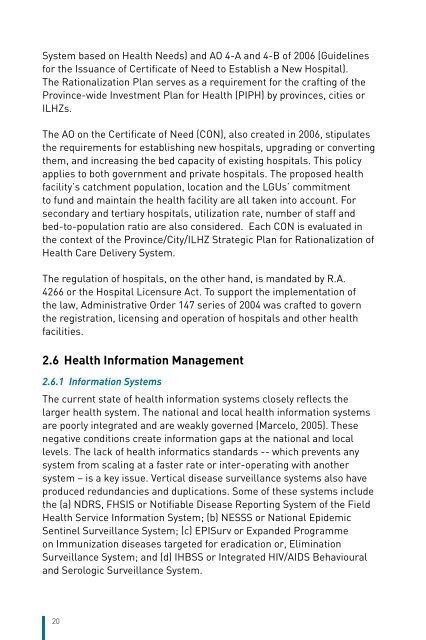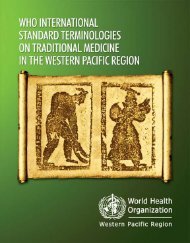The Philippines Health System Review - WHO Western Pacific ...
The Philippines Health System Review - WHO Western Pacific ...
The Philippines Health System Review - WHO Western Pacific ...
- No tags were found...
Create successful ePaper yourself
Turn your PDF publications into a flip-book with our unique Google optimized e-Paper software.
<strong>System</strong> based on <strong>Health</strong> Needs) and AO 4-A and 4-B of 2006 (Guidelinesfor the Issuance of Certificate of Need to Establish a New Hospital).<strong>The</strong> Rationalization Plan serves as a requirement for the crafting of theProvince-wide Investment Plan for <strong>Health</strong> (PIPH) by provinces, cities orILHZs.<strong>The</strong> AO on the Certificate of Need (CON), also created in 2006, stipulatesthe requirements for establishing new hospitals, upgrading or convertingthem, and increasing the bed capacity of existing hospitals. This policyapplies to both government and private hospitals. <strong>The</strong> proposed healthfacility’s catchment population, location and the LGUs’ commitmentto fund and maintain the health facility are all taken into account. Forsecondary and tertiary hospitals, utilization rate, number of staff andbed-to-population ratio are also considered. Each CON is evaluated inthe context of the Province/City/ILHZ Strategic Plan for Rationalization of<strong>Health</strong> Care Delivery <strong>System</strong>.<strong>The</strong> regulation of hospitals, on the other hand, is mandated by R.A.4266 or the Hospital Licensure Act. To support the implementation ofthe law, Administrative Order 147 series of 2004 was crafted to governthe registration, licensing and operation of hospitals and other healthfacilities.2.6 <strong>Health</strong> Information Management2.6.1 Information <strong>System</strong>s<strong>The</strong> current state of health information systems closely reflects thelarger health system. <strong>The</strong> national and local health information systemsare poorly integrated and are weakly governed (Marcelo, 2005). <strong>The</strong>senegative conditions create information gaps at the national and locallevels. <strong>The</strong> lack of health informatics standards -- which prevents anysystem from scaling at a faster rate or inter-operating with anothersystem – is a key issue. Vertical disease surveillance systems also haveproduced redundancies and duplications. Some of these systems includethe (a) NDRS, FHSIS or Notifiable Disease Reporting <strong>System</strong> of the Field<strong>Health</strong> Service Information <strong>System</strong>; (b) NESSS or National EpidemicSentinel Surveillance <strong>System</strong>; (c) EPISurv or Expanded Programmeon Immunization diseases targeted for eradication or, EliminationSurveillance <strong>System</strong>; and (d) IHBSS or Integrated HIV/AIDS Behaviouraland Serologic Surveillance <strong>System</strong>.20
















